Three ways retail design can help shape the new urban economy
Retail areas play a fundamental role in the development of cities

Restaurants, cafes, shops, markets, barbershops, clubs, cinemas… Retail spaces are much more than they seem. Beyond even the most modest cornershop lies an impressive urban machine of which they play a fundamental part. Retail spaces provide much more than just goods and services: they anchor local communities, vitalize local economies, catalyze our emotional well-being, offering leisure, diversion and employment to whole cities from the bottom-up.
Good retail design must therefore have a comprehensive view that appreciates its impact throughout the urban economy. Crucial to this is the question of sustainability. Most retail spaces are no longer passed down generation to generation. Today the average lifespan of a retail store is only 8,5 years. Every time a tenant changes, a full rebuild is necessary, requiring the demolition of 80% to 100% of the previous built environment.
While these rotations have a positive impact on the architecture and construction industry, they are often carried out without holistic considerations about the source and quality of materials, the skill of the labour employed, and the well-being of their final users. In other words, every time we do not make a sustainable rotation we are wasting an incredible opportunity to build back better, boosting the local economy and upgrading the retail fabric.
These are three ways to make it different:
1. Adopt a circular economy (design for disassembly and waste management).
One of the biggest challenges in this rotation is what to do with all the waste left behind in each refurbishment. In Spain, only 17% of construction waste is recycled or reused. This is very cost-ineffective. The use of adhesives and excessive combinations of different materials make construction waste hard to separate and therefore hard to reuse. But this can be solved.
First, both clients and designers should be making greater efforts in preserving and adapting existing architecture elements. Second, architects should think ahead and design construction systems that allow for an end-of-life disassembly. Third, we all should adopt a circular economy philosophy, thinking from a closed-loop perspective that “minimises the use of new resource inputs while reducing the creation of waste”.
2. Promote local supply chains (artisanship and middle-skill employment).
Globally, we are letting go of an extremely capable, talented and skilled workforce of artisans. Due to their smaller capacity for outreach and their limited technology which increases their end prices, they have become hardly competitive against their cheaper better-marketed competitors. This is a waste of their talents, and a waste for the local economy: were we to employ them, wages in the industry would rise, providing a boost to families and increasing even our potential consumer base.
Artisanal expertise on the applications and possibilities of materials as well as their appreciation of raw resources is of extreme value for the circular economy: they love what they create, and would hate to waste it. Furthermore, the materials they work with are extracted locally which means that their thermal and environmental properties are more climate-efficient than imported materials. Lastly, their knowledge and skills enhance and purify projects. In my experience working with them, artisans are always flexible and eager to collaborate to achieve the best quality outcome.
3. Understand material health (resilience in building and healthy materials).
From food or beauty to cleaning products, health has already taken over many sectors but it is yet to be fully explored in the construction industry. There is little transparency regarding the source and chemical composition of construction materials. We now know that long-term exposure to certain chemicals found in them can cause severe health problems that range from asthma, chemical hypersensitivity or allergies to hormonal imbalance and even cancer.
As designers it is our responsibility to ensure the appropriate prescription of the materials we design with. And as consumers it is our right to be fully informed about all the consequences that certain cheaper materials choices might bring along. Building back better, means building healthier environments. Luckily, this often goes hand in hand with procuring artisanal labour that use natural and locally sourced materials.
A call for action
It is not just us the designers who are to facilitate this process, but the consumers, workers and developers who should kickstart the cycle. Appreciating brands that include these values in their practice, being willing to pay more for a higher quality, refusing to build ephemerally, thinking long-term, valuing local skills and local materials. To give more is to receive more in terms of more dynamic cities and greater opportunities for leisure and emotional wellbeing. The revolution starts within, and ends with a new urban economy that is less volatile and unsustainable, where risk is mitigated at every link of the production chain, and the best way to grow is to rebuild.
